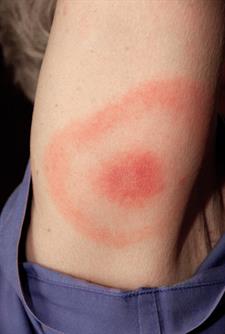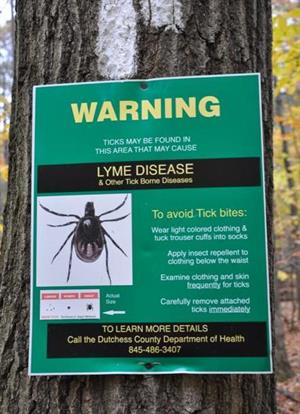by Jordan Bowman
Senate Bill Aims to Combat Lyme Disease
June 24, 2016
This summer, the U.S. Senate will consider the Lyme and Tick-Borne Disease Prevention, Education, and Research Act of 2015 (S. 1503). This important piece of legislation is a vital step toward reducing occurrences of tick-borne illnesses and providing better treatment for those afflicted. To find out more about the bill, why further research is needed and how you can express your support of this legislation, continue reading.
“You’re actually really lucky if you see the tick…”
 In March 2015, Marie Uehling, Major Gifts Officer for the Appalachian Trail Conservancy (ATC), thought she had come down with the flu. Fever, chills, a killer headache — all of it added up.
In March 2015, Marie Uehling, Major Gifts Officer for the Appalachian Trail Conservancy (ATC), thought she had come down with the flu. Fever, chills, a killer headache — all of it added up.
Then she noticed a small rash forming behind her knee.
“At that point I said to myself, ‘Oh, it’s definitely from a tick,’ and I immediately went to the doctor,” she said. She had spent time hiking in the North Carolina mountains when the weather had finally started to warm up. “That is apparently where I picked up Rocky Mountain Spotted Fever.”
Fortunately, due to her knowledge of tick-borne illnesses and their symptoms, Marie knew to seek medical help. She was able to start treatment immediately — a round of heavy antibiotics — and had begun to recover. Life had returned more-or-less to normal, and she continued to enjoy her hikes in the mountains near ATC headquarters in Harpers Ferry, WV.
And then, approximately six weeks after the first tick bite, she felt the flu-like symptoms develop once again, and a small bulls-eye rash began to appear on the top of her wrist. She went back to the doctor, where she was ultimately diagnosed with the most commonly reported vector-borne illness in the United States: Lyme disease.
“The doctor said that it was … an unusual situation,” Marie said. “She rarely sees as many tick infections as I had, and she knew that was trouble from the start because it was going to be harder to treat. And the fact that I had apparently picked up a tick in two different locations did make it more complex.”
Marie once again started antibiotics, but due to the complications of having both Lyme disease and Rocky Mountain Spotted Fever — and, as her doctor noted, potentially several other tick-borne illnesses — it was six months before she began to feel like herself again.
“My body was really beaten down,” she said, glancing down at the wrist where the bulls-eye rash had first appeared. “It was a long treatment and healing process.”
In both instances of being bitten, despite taking precautions and performing tick checks after her hikes, Marie never saw any sign of a tick having been attached to her skin until the symptoms appeared.
“They must have dropped off before I noticed them,” she said. “That’s one thing I will say to anybody. You’re actually really lucky if you see the tick, if it happens in a place where you can see it yourself. And they’re so tiny, they’re very easy to overlook. A lot of people never see the tick. They feel the symptoms and they may see the rash, and even that doesn’t happen with everybody.”
Still, despite all of the pain caused by these infections, Marie stated that this incident would never keep her out of the woods and off the Appalachian Trail (A.T.).
“I don’t want people to think that they should be scared to go out there,” she said. “They just need to be prepared and cautious.”
Lyme Disease and Other Tick-Borne Illnesses
While stories of bears, wrong turns and things that go bump in the night are some of the most talked-about risks of hiking on the A.T., the true menaces of the backwoods — ticks — might be as small as the tip of a ballpoint pen. Marie’s story is an important one, as it highlights that even seasoned outdoor enthusiasts who take precautions against tick bites are still at risk of infection whenever they step into the backcountry — or, as Marie stated, “even by walking through tall grass in your yard.” While contracting more than one infection in such a close time frame is rare, Marie joined potentially hundreds of thousands of Americans who were infected by Lyme disease or other tick-borne illnesses in 2015.
 Although each of these diseases is harmful — some potentially fatal — Lyme disease is particularly troublesome. It is spread by the tiny deer tick, a species that lives along the entire length of the A.T., and it is estimated that up to 50 percent of adult deer ticks carry the Lyme disease bacterium. This disease is rarely fatal, but it can cause lifelong, painful consequences when left untreated. Unfortunately, while somewhere between 70-90 percent of infected people experience at least one of these symptoms, some do not experience any of them until weeks or months later, when the disease has already begun to do more severe damage. Blood samples can help doctors diagnose infected patients, but if the blood is analyzed too soon after the transmission of the Lyme disease bacterium, current tests may return a false negative — and a false sense of security for the infected individual.
Although each of these diseases is harmful — some potentially fatal — Lyme disease is particularly troublesome. It is spread by the tiny deer tick, a species that lives along the entire length of the A.T., and it is estimated that up to 50 percent of adult deer ticks carry the Lyme disease bacterium. This disease is rarely fatal, but it can cause lifelong, painful consequences when left untreated. Unfortunately, while somewhere between 70-90 percent of infected people experience at least one of these symptoms, some do not experience any of them until weeks or months later, when the disease has already begun to do more severe damage. Blood samples can help doctors diagnose infected patients, but if the blood is analyzed too soon after the transmission of the Lyme disease bacterium, current tests may return a false negative — and a false sense of security for the infected individual.
Approximately 30,000 cases of Lyme disease are reported to the Centers for Disease Control and Prevention (CDC) every year. However, the CDC believes that cases are underreported, and that the number of affected Americans is actually as high as 300,000 cases per year — ten times the number that is currently documented. Even this estimated rate does not include people who contract the disease but are misdiagnosed, have false negatives on their blood tests or fail to go to a doctor at all.
“We know that routine surveillance only gives us part of the picture, and that the true number of illnesses is much greater,” said Paul Mead, chief of epidemiology and surveillance for CDC’s Lyme disease program, in a CDC press release. “This new preliminary estimate confirms that Lyme disease is a tremendous public health problem in the United States, and clearly highlights the urgent need for prevention.”
While Lyme disease is the most prevalent tick-borne illness in America — particularly in the Northeast and upper Midwest — it is not the only serious infection humans can contract from ticks. And while current methods of preventing tick bites significantly reduce the chances of contracting one of these diseases, they do not offer full protection.
“Although these measures are effective, they aren’t fail-proof and people don’t always use them,” said Lyle R. Petersen, director of CDC’s Division of Vector-Borne Diseases, in a CDC press release.
Advocating for Change
With so many Americans at risk of contracting Lyme disease and other tick-borne illnesses, it is vitally important to educate the public about preventing tick bites and support research into how we can better treat or, ideally, prevent these dangerous diseases in the first place.
This is the overall purpose of the Lyme and Tick-Borne Disease Prevention, Education, and Research Act of 2015 (S. 1503). Should this act be approved, it will set in place two actions that directly address the need for further research into Lyme disease and other tick-related illnesses, and for more education programs designed to inform the public about proper prevention of tick bites, the recognition of symptoms and methods of treatment.
 The first action will be the creation of a Tick Borne Diseases Advisory Committee comprised of physicians, scientific experts, patients and Lyme disease advocates. This committee will work with the Secretary of the U.S. Department of Health and Human Services (HHS) to ensure that thorough research makes it into the hands of our federal health agencies and other organizations, and that it is being considered when public health and policy decisions are made.
The first action will be the creation of a Tick Borne Diseases Advisory Committee comprised of physicians, scientific experts, patients and Lyme disease advocates. This committee will work with the Secretary of the U.S. Department of Health and Human Services (HHS) to ensure that thorough research makes it into the hands of our federal health agencies and other organizations, and that it is being considered when public health and policy decisions are made.
The second action of the bill will require the HHS Secretary to conduct or support activities such as developing diagnostic tools and tests for tick-borne diseases, improving the use of currently available tests, improving surveillance and reporting of Lyme and other tick-borne diseases and increasing public education and awareness.
The implementation of the Lyme and Tick-Borne Disease Prevention, Education, and Research Act could vastly improve the prevention and treatment of Lyme disease and other tick-borne illnesses. We encourage our members and all outdoor enthusiasts to support this bill by contacting their U.S. senators and voicing the importance of combating these debilitating illnesses through education, prevention and continued research.





